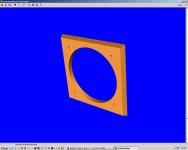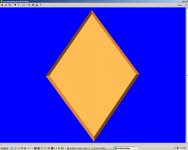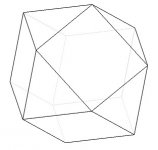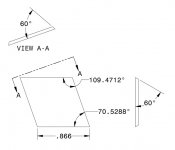Gentlemen:
You can easily see from my previous post that since I started with a unit cube, you can get the piece side lengths for any desired size RD by simple multiplication. It all keys off the side of the square baffle plate, which is nice because you need to allow enough room to fit the woofer without making too-narrow slivers of wood around the cutout that might crack during assembly if you use thin materials.
When I first started making these I made a stupid mistake and tried to save time by cutting rhombi into half-rhombi. Don't do that. The width of wood eaten by the saw blade makes the resulting triangles too small to fit the square.
Once you have decided what your square side length S will be,
Rhombus side length = S x .866
Triangle side lengths are S, (.866)S, (.866)S
You can easily see from my previous post that since I started with a unit cube, you can get the piece side lengths for any desired size RD by simple multiplication. It all keys off the side of the square baffle plate, which is nice because you need to allow enough room to fit the woofer without making too-narrow slivers of wood around the cutout that might crack during assembly if you use thin materials.
When I first started making these I made a stupid mistake and tried to save time by cutting rhombi into half-rhombi. Don't do that. The width of wood eaten by the saw blade makes the resulting triangles too small to fit the square.
Once you have decided what your square side length S will be,
Rhombus side length = S x .866
Triangle side lengths are S, (.866)S, (.866)S
speed of light maximal rules
Does the theory say that speed of light is max, or that one cannot cross the speed of light barrier (ie there could be a whole "world" of faster than light)?
dave
Does the theory say that speed of light is max, or that one cannot cross the speed of light barrier (ie there could be a whole "world" of faster than light)?
dave
In quantum mechanics things can happen instantaneously on a probabilistic level. With quantum entanglement for instance, the spin state of one particle from a two particle quantum entangled process, is determined at the instant when the measurement is imposed. You then know with 100% certainty the spin state of the other particle - even if it is very far away without ever having to measure its spin state. Thus, the paradox of having this instantly formed knowledge, but no way to transmit it to verify if the other particle is indeed what you know it to be. The speed of light can be exceeded according to relativistic physics - you just need very light weight particles. For practical particles with mass - tough to do. So for information stored as quantum bits on a photon, even it has a mass (relativistic mass = 10^-18eV/c^2) that comes into play thus limiting max speed to c.
A little OT but fun to think about.
Last edited:
...Thus, the paradox of having this instantly formed knowledge, but no way to transmit it to verify if the other particle is indeed what you know it to be.
I'm sure that some people will disagree 😀
Researchers working at TU Delft's Kavli Institute of Nanoscience in the Netherlands claim to have successfully transferred data via teleportation. By exploiting the quantum phenomenon known as particle entanglement, the team says it transferred information across a 3 m (10 ft) distance, without the information actually traveling through the intervening space.
Link
Granted, it's been a long time since I took the class, but I don't recall any situation where the speed of light could be exceeded in general relativity. (quantum weirdness notwithstanding)
Is this some new interpretation? (PM me if this is getting to OT)
RE the original topic, I think we are operating entirely in the world of newton here... I suppose if there are any physicists here that want to show off, relativistic effects could be included in calculations for speakers, but the effect would be infinitesimal.
Is this some new interpretation? (PM me if this is getting to OT)
RE the original topic, I think we are operating entirely in the world of newton here... I suppose if there are any physicists here that want to show off, relativistic effects could be included in calculations for speakers, but the effect would be infinitesimal.
Gentlemen:
You can easily see from my previous post that since I started with a unit cube, you can get the piece side lengths for any desired size RD by simple multiplication. It all keys off the side of the square baffle plate, which is nice because you need to allow enough room to fit the woofer without making too-narrow slivers of wood around the cutout that might crack during assembly if you use thin materials.
When I first started making these I made a stupid mistake and tried to save time by cutting rhombi into half-rhombi. Don't do that. The width of wood eaten by the saw blade makes the resulting triangles too small to fit the square.
Once you have decided what your square side length S will be,
Rhombus side length = S x .866
Triangle side lengths are S, (.866)S, (.866)S
For the geometrically challenged.....I've looked at the links, but really don't have a good visual on how to efficiently cut the pieces out of wood and to see what it looks like from all sides; a cut sheet showing the bevels would be immensely helpful. In one photo the enclosure appears to sit flat and in another it appears to be angled or on edge. (I think I read) Are you planning on showing a "practical" step by step build or do we just have to buy the book?
For the geometrically challenged.....I've looked at the links, but really don't have a good visual on how to efficiently cut the pieces out of wood and to see what it looks like from all sides; a cut sheet showing the bevels would be immensely helpful. In one photo the enclosure appears to sit flat and in another it appears to be angled or on edge. (I think I read) Are you planning on showing a "practical" step by step build or do we just have to buy the book?
I hope these CAD screenshots plus the pictures at Futiquity help. If I may suggest constructing a paper model first:
Paper Model of a Rhombic Dodecahedron
I drew pencil lines on mine right away cutting each rhombus in half along it's minor axis (lines running across each rhombus connecting the two obtuse corners). This made it much easier to see the pyramids. It can be a difficult shape to get your head around at first since there are two types of corners : one where 3 pieces meet and another where 4 meet (pyramid points)). Once square truncated, the enclosure can be situated in two ways. One way is with the driver facing you straight on (like with a typical enclosure) or you can rotate the enclosure 45 deg and the driver will be facing up at 45 deg. --Greg
Attachments
Last edited:
For the geometrically challenged.....I've looked at the links, but really don't have a good visual on how to efficiently cut the pieces out of wood and to see what it looks like from all sides; a cut sheet showing the bevels would be immensely helpful. In one photo the enclosure appears to sit flat and in another it appears to be angled or on edge. (I think I read) Are you planning on showing a "practical" step by step build or do we just have to buy the book?
Must have missed my post #34:
http://www.diyaudio.com/forums/full-range/265053-hypercube-loudspeakers-4.html#post4126628
An externally hosted image should be here but it was not working when we last tested it.
Take above shape and lop off one pointy vertex to get a square baffle.
I'm sure that some people will disagree 😀
Researchers working at TU Delft's Kavli Institute of Nanoscience in the Netherlands claim to have successfully transferred data via teleportation. By exploiting the quantum phenomenon known as particle entanglement, the team says it transferred information across a 3 m (10 ft) distance, without the information actually traveling through the intervening space.
Link
These are confirmed (independently verified) experiments so it's no joke. They actually do have to transmit info between the space via electrons (but they do not know what info is contained in the electrons). If one tried to read the info in the signal, the entanglement collapses and no quantum teleportation occurs. Not much can be done with mass teleportation but this concept is extremely powerful and crucial for quantum computers which are massively parallel and can crack standard encryption algorithms in several cpu cycles. There is a commercial quantum computer (D-Wave) owned by Google - uses supercooled Josephson junctions. Qubits are fun - they are either a 1 or 0 simultaneously. 🙂
Think your encrypted data is safe? Guess who owns the other unit?
Last edited:
Must have missed my post #34:
http://www.diyaudio.com/forums/full-range/265053-hypercube-loudspeakers-4.html#post4126628
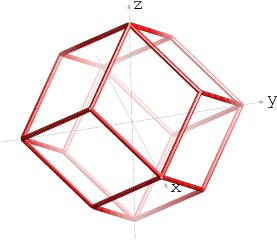
Take above shape and lop off one pointy vertex to get a square baffle.
Well put. What threw me for a loop was when I saw a photo of a triangle truncated version...didn't know what I was looking at initially. Since then I think the inventors have decided that the square truncated version is better since it places the baffle on a displacement antinode where the driver can most blend in with the backwave. Also the square baffle version can be made smaller.
End result of cutting off one of the corners looks like the attached image.
I've also attached a technical drawing of one of the Rhombic sides. If that's what others would like for making the parts I can make a full set for all three parts needed. The sizes in the drawing are with the square baffle at a length of 1. I noticed that my angles are slightly different from posted earlier, not sure where the difference comes from, but these come from my CAD model which is based off of geometry. I'm sure my numbers are correct.
Just for fun I also set the baffle length to 4.25 inches, made the walls 6mm thick and set the material to acrylic and ran a modal model. Of course this assumes perfectly joined corners and there was no speaker, but the model showed this thing is really stiff. The first mode (not including the square baffle moving like a drum) was at 3404 Hz. Then jumps to 4435 and on up.
I've also attached a technical drawing of one of the Rhombic sides. If that's what others would like for making the parts I can make a full set for all three parts needed. The sizes in the drawing are with the square baffle at a length of 1. I noticed that my angles are slightly different from posted earlier, not sure where the difference comes from, but these come from my CAD model which is based off of geometry. I'm sure my numbers are correct.
Just for fun I also set the baffle length to 4.25 inches, made the walls 6mm thick and set the material to acrylic and ran a modal model. Of course this assumes perfectly joined corners and there was no speaker, but the model showed this thing is really stiff. The first mode (not including the square baffle moving like a drum) was at 3404 Hz. Then jumps to 4435 and on up.
Hi,
You cannot use quantum entanglement to transfer information
faster than the speed of light. Once you measure the "spin" of one
of the particles you know the "spin" of the other intanstaneously,
but seeing you haven't got a clue what "spin" your going to
measure there is no chance of transferring information.
The speed of light can be exceeded according to relativistic
physics - you just need very light weight particles.
Mentioning weight in terms of particles is pretty clueless.
And your totally wrong. According to relativistic physics
nothing can exceed the speed of light, only massless
particles travel at the speed of light, and a particle of
any mass (e.g. an electron) inbued with the energy of
the entire universe would still not travel faster than C.
Further :
The neutrino transit time is not being hotly debated
as we speak, its dead and buried as an error, and
IMO god save us from anyone who really knows
their stuff but chooses to talk utter garbage.
rgds, sreten.
You cannot use quantum entanglement to transfer information
faster than the speed of light. Once you measure the "spin" of one
of the particles you know the "spin" of the other intanstaneously,
but seeing you haven't got a clue what "spin" your going to
measure there is no chance of transferring information.
The speed of light can be exceeded according to relativistic
physics - you just need very light weight particles.
Mentioning weight in terms of particles is pretty clueless.
And your totally wrong. According to relativistic physics
nothing can exceed the speed of light, only massless
particles travel at the speed of light, and a particle of
any mass (e.g. an electron) inbued with the energy of
the entire universe would still not travel faster than C.
Further :
The neutrino transit time is not being hotly debated
as we speak, its dead and buried as an error, and
IMO god save us from anyone who really knows
their stuff but chooses to talk utter garbage.
rgds, sreten.
Last edited:
I suggest that anyone (who hasn't already - and skeptical or not) read the patent. It is really quite funny. 😉
https://www.google.com/patents/US42...a=X&ei=8W9uVKWjI8aQyASZ64GQAQ&ved=0CB0Q6AEwAA
One of my favorite lines:
"The distortion is of the "flubby" type which destroys crispness and generally deteriorates the quality of the sound."
For some other useless patents, which are actually fairly well written:
https://www.google.com/patents/US63...a=X&ei=oHJuVPzSD42pyASyu4DYDg&ved=0CB8Q6AEwAA
https://www.google.com/patents/US54...NbdOsugyATazIKIDA&sqi=2&pjf=1&ved=0CB0Q6AEwAA
https://www.google.com/patents/US42...a=X&ei=8W9uVKWjI8aQyASZ64GQAQ&ved=0CB0Q6AEwAA
One of my favorite lines:
"The distortion is of the "flubby" type which destroys crispness and generally deteriorates the quality of the sound."
For some other useless patents, which are actually fairly well written:
https://www.google.com/patents/US63...a=X&ei=oHJuVPzSD42pyASyu4DYDg&ved=0CB8Q6AEwAA
https://www.google.com/patents/US54...NbdOsugyATazIKIDA&sqi=2&pjf=1&ved=0CB0Q6AEwAA
Hi,
You cannot use quantum entanglement to transfer information
faster than the speed of light. Once you measure the "spin" of one
of the particles you know the "spin" of the other intanstaneously,
but seeing you haven't got a clue what "spin" your going to
measure there is no chance of transferring information.
The speed of light can be exceeded according to relativistic
physics - you just need very light weight particles.
Mentioning weight in terms of particles is pretty clueless.
And your totally wrong. According to relativistic physics
nothing can exceed the speed of light, only massless
particles travel at the speed of light, and a particle of
any mass (e.g. an electron) inbued with the energy of
the entire universe would still not travel faster than C.
Further :
The neutrino transit time is not being hotly debated
as we speak, its dead and buried as an error, and
IMO god save us from anyone who really knows
their stuff but chooses to talk utter garbage.
rgds, sreten.
Maybe you did not read what I said carefully. We are in agreement that info cannot be transmitted faster than speed of light. And relativistic mass needs to be less than 10^-18eV/c^2 - notice how it is specified as energy and not kg.
Ya... so how 'bout we drop the stuff not related to the funky cabinet shape.
You got it Cal. Back to our regular programming.
As soon as I have time, a foam core version with a TC9FD will be coming, and with measurments.
MuddJester:
Wow. Thanks for your work. The thumbnails look great. Indeed, I observed a mild resonance at 3.4k and I suppose if dig deeper into the decay I'll find one at 4.4k as well. Do you find it interesting that the 1.55k resonance that I observed seems to correspond to the cube that fits inside the enclosure (one face of which is the baffle) and not to a mode?
For what it's worth, the 4.25" baffle measurement I quoted is quite close but when I get home tonight I can dig up my cad files and tell you exactly what my dimensions were if you think it might make a meaningful difference.
I for one would up for building a slightly larger model in the future (something like the Alpair-10P might be nice) but felt it might be premature to talk about a group build at this point.
Wow. Thanks for your work. The thumbnails look great. Indeed, I observed a mild resonance at 3.4k and I suppose if dig deeper into the decay I'll find one at 4.4k as well. Do you find it interesting that the 1.55k resonance that I observed seems to correspond to the cube that fits inside the enclosure (one face of which is the baffle) and not to a mode?
For what it's worth, the 4.25" baffle measurement I quoted is quite close but when I get home tonight I can dig up my cad files and tell you exactly what my dimensions were if you think it might make a meaningful difference.
I for one would up for building a slightly larger model in the future (something like the Alpair-10P might be nice) but felt it might be premature to talk about a group build at this point.
.
And relativistic mass needs to be less than 10^-18eV/c^2
- notice how it is specified as energy and not kg.
Hi,
What on earth are you talking about ? In relativity any
particle with any mass, no matter how small, can absorb
any amount of energy, becoming supermassive near the
speed of light. Your clueless about equations balancing,
mass = E/Csquared is actually the form Einstien used.
Saying the relativistic mass needs to be below a nonsense
value to travel faster than the speed of light is nonsense.
Nothing can exceed the speed of light, in our universe.
rgds, sreten.
Last edited:
- Status
- Not open for further replies.
- Home
- Loudspeakers
- Full Range
- Hypercube Loudspeakers
